#it was on that old paley thing
Explore tagged Tumblr posts
Text
never getting over Mads thinking the interviewer, who simply asked about his and Hugh's chemistry, was asking if they fucked in real life like buddy. BUDDY
#tbh he sold himself right then and there lmao#the poor guy was like SIR NO SIR NO#it was on that old paley thing#nbc hannibal#hannigram#will graham#hannibal#murder husbands#hannibal lecter#hugh dancy#mads mikkelsen
269 notes
·
View notes
Text
Compilation of Eric Bogosian exposing Jam
He keeps saying the most ambiguous things about Jacob and Sam relationship 🤣 (at this point i feel that even the cast is praying for an affair).
The wildest things he said so far was "i've never seen two actors in a company behave the way these 2 guys behave" (he is old af and with so many projects and he never saw something like that in his many years of career?! 🤨 so it have to be worse than just an affair), "i don't wanna characterize what goes on between them"💀 and "the only difference between these two and their characters is that I've never seen them fight" (excuse me sir 🤨 that can't possible be the only "F" word that you never saw them doing 😱💀)
Videos: newstalkzb - Eric Bogosian Talking about Sam Reid and Jacob Anderson Chemistry, The Paley Center for Media - Interview With the Vampire at PaleyFest Fall TV Previews 2022, Interview with the Vampire Press Conference at SDCC 2022, Screen Rant Plus -Interview With The Vampire: San Diego Comic-Con 2022 and The 92nd Street Y New York 'Anne Rice's Interview with the Vampire' Season 2: Cast and Creators in Conversation
#jam reiderson#sam reid#jacob anderson#eric bogosian#i finally did the compilation#you sure there's no other differences Eric?! like i never saw them f*cking for example 👀#he spent a day w/ them at a comic con and was so done with them that decided to expose them in every opportunity he have 🤣#i pray for jam to get paired w/ eric for at least in one interview in season 3#so he expose them a bit more after having to third wheel them even more
38 notes
·
View notes
Note
Hi! Not sure if you've talked about this but did B and M knew each other before the show? What did their timeline look like? Thank you for always replying!
Hiya :)
No, they didn't know each other beforehand. They met at their chemistry read which took place a couple of weeks before shooting the pilot, so probably late February 2003. Ben was the last principal actor cast and iirc was officially cast like a week or two before they shot the pilot.
I can give you a rough timeline of the bare bones of things during s1. I have a more detailed timeline because I'm insane and curious and hyperfixate on things. And I know that sounds weird and cagey lol but I always try to answer things as best as I can. I've spent a ~lot~ of time putting things together and combing dead sites, reading old tabloids, etc. And MB sometimes speaks in hyperbole so when she says "right out of the gate" I don't necessarily take that to mean during the pilot shoot. But I also don't know. I think these two have sparks on overdrive during the iconic "Whoever you want me to be" scene and I think everyone on set could easily tell. So.
Late February 2003: meet at chemistry test
Mid-March: film the pilot
Mid-May: upfronts in New York, followed by the first Camp Gallagher with all the regulars, resume filming soon after
June: MB mentions going to cast dinners
Late July: premiere party (these pics have always been SO couple-y); think they're filming 106 at this point
Early August: teen choice awards, the pilot airs 3 days after this. so that's 3 months of the cast partying and living in relative anonymity; MB is a rising it girl (and was before the show) but not papped
September 8: MB on Kimmel, her first late night talk show and she is so sweet and clearly not yet media trained
September 12: Ben's 25th birthday
Late October: Ben/Mischa/Adam go to New York on a press trip (YM party/TRL); TRL is the loudest piece of evidence in the world
December 4: Motorola. Scratch what I just said. Motorola is the biggest piece of evidence in the world; BM are quite literally on the cover of Us Weekly two and a half weeks later because of Motorola shenanigans. A blogger at E says they've been together for months; the final scene of 115 is shot earlier this day
December 10: Billboard Awards in Vegas. At this point AR are clearly also dating but both couples are on their best behavior
January 24, 2004: Mischa's 18th birthday. Tabloid says Ben was there with Rachel/Melinda/Samaire but that Adam missed the party. At this point in time tabloids barely talked about the cast and had little reason to lie. So many tabloids from this era ended up being true which is just... wild
January 25: Golden Globes. BM are pictured together, holding hands dancing, etc; MB and her rep deny the rumors in the press immediately after
Which brings me to the breakup. Or at least a break. A lot of couples in this era made their debuts as couples once the girl turned 18 (think Wilmer/Lindsay) so it's been assumed forever that that's what the GGs were doing. But for MB to quickly deny it still tells me the wheels fell off very quickly with them. I assume there was a BUNCH of weirdness being thrown at her from all sides about turning 18 too. All of this is so so sooooo insane to me still btw
February 24: MB denies dating Ben to Ellen and meets Brandon the same day this airs
Early March: MB starts dating Brandon
March 9: Paley Fest; AR/BM deny dating rumors, Ben opines about the press invasions into his personal life, says he wishes the rumors were true; they are filming 124 at this time
March 11: MB walks a red carpet with Brandon
March-April is Mischa/Brandon PDA 24/7 and I imagine TPTB/Ben are extremely pissed at her for it
April 20: s1 finale party (127 finished filming a few days before); BM do not pose for photos together
Aaaaaand this is just s1
#ask#anonymous#mb tea#like i said i am insane#mb girl if u need a fact checker for ur probably forthcoming memoir hmu
9 notes
·
View notes
Text
Voiceplay Visuals: Hide And Seek (Ding Dong!)
This was Voiceplay's Halloween video of 2022, released on the 8th of October, and features Lauren Paley, who I don't really know anything about, but apparently she's popular on Tiktok and is known as "the stairwell siren" due her typical choice of singing location. The song is originally a Vocaloid song, but Voiceplay gave it a little bit (understatement of the century) of Disney flair, or more specifically, Disneyland flair, as the video is filmed as if you were watching a performance inside the Haunted Mansion attraction at Disneyland, literally. This might not be one of my most-favourite videos to watch or VP songs to listen to, but I gotta admit that the visual stuff is freaking insane in this video, and I do have a fair few things to talk about with this one, so let's get into it!
(Warning: this post includes a fair bit of infodumping)
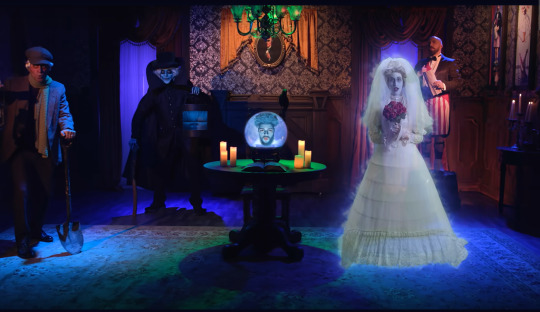
I'll get to each person individually in a minute, but first check out the set design! Like a lot of Voiceplay's videos nowadays. this was filmed at Pattycake Productions studios, and Tony Wakim was heavily involved with this one - credited with costuming, props, puppeteering, and direction, so shoutout to him! And shoutout also to Layne, the other half of Pattycake Productions, who arranged the cover and was in charge of the video concept.
I've never been to DisneyLand/World (I've never even been overseas, and there are no Disney parks in Australia), but when I was a little younger (like during mid high school?) I went through a bit of a phase of interest in Disney parks, wanting to learn stuff about them and watching shows from the parks on YouTube and stuff (if only I had been watching shows from Universal Studios in Orlando...), so I'm not entirely unfamiliar with the Haunted Mansion ride/attraction, and I currently have Disney Wiki on hand to help provide further elaboration and comparison pictures.

Alright, character time!
Let's start with Cesar in the middle, who is absolutely serving as Madame Leota, a disembodied head in a crystal ball who conducts "an otherworldly séance in an attempt to summon spirits and assist them in materializing." (And I'm not meant to be talking about the arrangement, but I would feel bad if I didn't mention that the "serpents and spiders" incantation that Cesar does before the beat kicks in is actually part of Madame Leota's incantation, not from the Hide And Seek song!) (Also fun fact: Madame Leota was originally voiced by Eleanor Audley, who also voiced both Lady Tremaine in Cinderella and Maleficent in Sleeping Beauty!)
Could you immediately tell based on just the thumbnail which one was Layne and which one was Geoff? I did actually get it right (could I really call myself a devoted Geoff stan if I didn't?), but honestly I did start to second-guess myself a little.
So in the left-hand column here, we have Layne, and my god Tony and Rick Underwood both really went off for this one. Layne is playing the Hatbox Ghost, who looks like this!
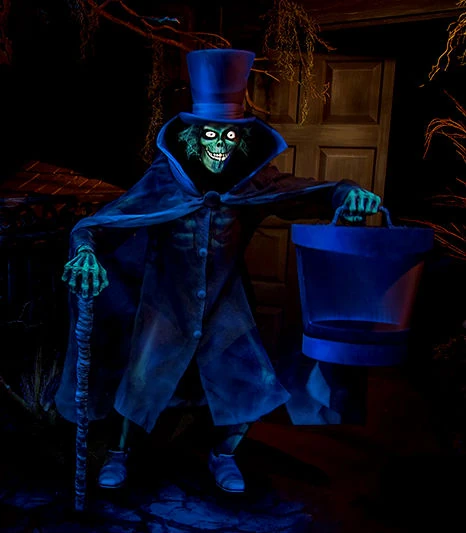
And if it weren't enough to be wondering how long Layne spent in the makeup chair for his extremely ghostly appearance (note that he's also completely clean-shaven, which is quite rare for him, but obviously necessary for the character look), then next we have Geoff, in the right-hand column, and do you see why I don't watch this video a lot? 😅 (I'm mostly joking, I'm not that shallow, but he's still practically unrecognisable!)
Geoff is playing The Caretaker (who apparently has the semi-official name of Silas Crump), who is the groundskeeper for the mansion and its adjacent cemetery, and he is terrified of the undead residents within the manor. He looks like this!
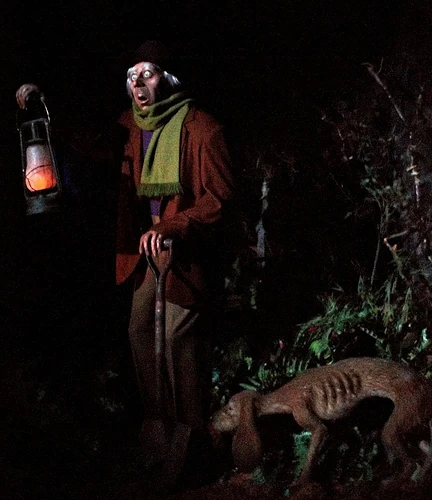
(Geoff, I know you love to call yourself "old [and boring]", but this is ridiculous 🤣)
(Not even 30 seconds into the video yet! Shoutout to anyone who actually reads this whole post!)
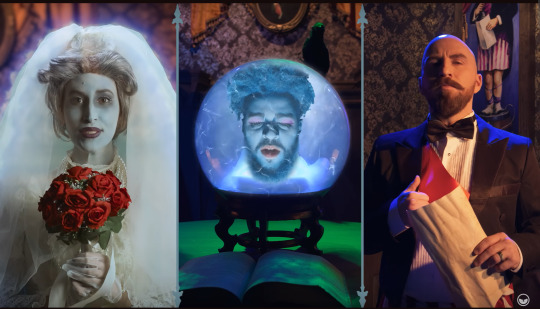
Next, we have Lauren, who is playing "The Bride". Apparently there were two iterations of this character in The Haunted Mansion, and I'm not sure which one Lauren is playing, or whether she's going for a mix of both, but here are pictures of the two versions:


The second iteration of The Bride (on the right) is known as Constance Hatchaway (not a typo!), and is one of the figures depicted in the Stretching Room's portraits. Apparently she had a habit of decapitating her husbands with a hatchet (hence the surname), and then stuffing their heads inside of hatboxes as trophies (lovely). According to lore, one of her husbands came into the possession of the manor now known as the Haunted Mansion, which she then inherited after her husband met the same grisly fate as all the previous ones did.
And finally we have Eli, perhaps the most recognisable member in this one, as Alexander Nitrokoff, another figure from the Stretching Portrait Gallery. He looks like this: (and yes, this portrait basically depicts his untimely end. Rip.)
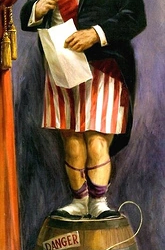
(10/10 casting choice, I must say, and outfit on point as well 👌)
OKAY, we've finally got character lore and introductions out the way, now we can actually get on with the video!
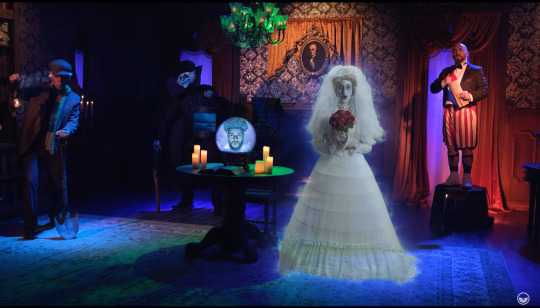
This picture is very similar to the first picture in this post, but I have more things to say about this set up!
One, I love the ghostly visual effects on Lauren, with the glowy ethereal outline of her silhouette, and the slight translucence on her dress! No clue who was responsible for visual effects/editing on this one (it doesn't say in the description, but maybe Layne?)
And 2, correct me if I'm wrong but are Geoff, Layne, and Eli all lit in different ways? Eli has a warm-coloured spotlight on him, Geoff has more of a cool-coloured spotlight on him (I think?), possibly angled different to the light on Eli as well, and as for Layne I'm honestly not sure, but he stands out in a really interesting way. I have a feeling that the lighting on him is such that it makes him look like an actual Haunted Mansion/Disney Parks ride animatronic (especially when combined with deliberate movement/acting choices in the video). Nobody is credited with lighting for this one, but I'll still place a bet on who helped with a lot of it (at the least) anyway!
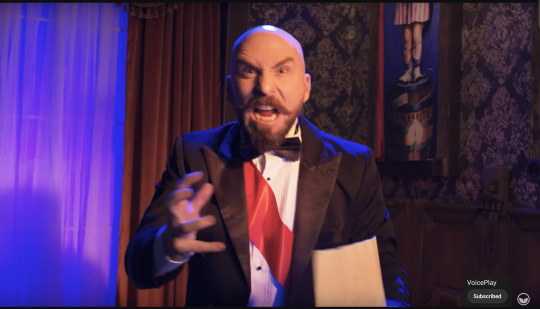
"Ding dong, you can't keep me WAITING!!!"
(Acting was on point across the board for this video, I must say)
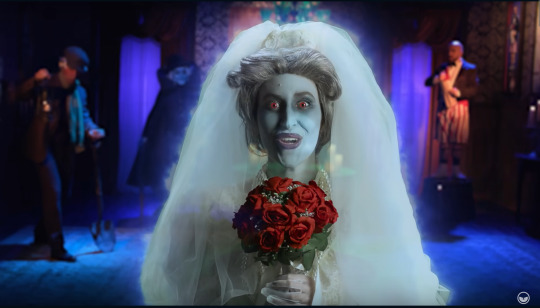
"I can sense your horror!"

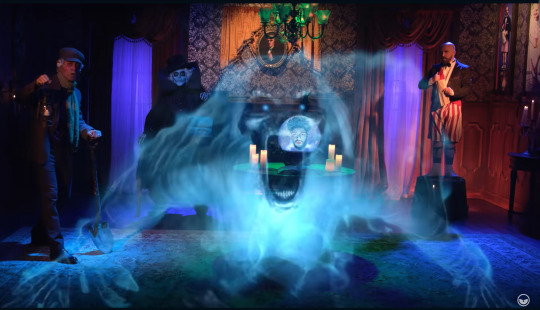
(JESUS-)

Absolutely loving Cesar's makeup in this one ngl (I wonder whether he coloured his face and/or hair blue for filming this or if that was just all done via editing?)
(Also great face Eli)
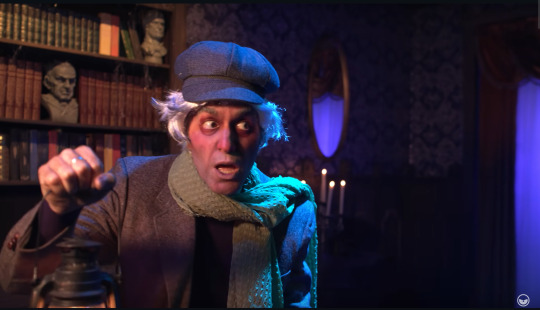
Honestly if not for his unmistakable vocal timbre, you could easily not realize this was Geoff at all. Rick did a ridiculously good job of making him (and Layne) look completely unrecognisable! Like is Geoff wearing facial prosthetics or something? His eyebrows look fake, the eyebags look like they were done with more than just regular makeup, and even his cheeks look thinner? Man I really wanna join VP's Patreon at the behind-the-scenes tier! But alas! Money!

Geoff: "Just wait, you can't hide from me"
Me while listening to the song on Spotify: 👉👈 👀
Me while watching the YouTube video: 😧😬

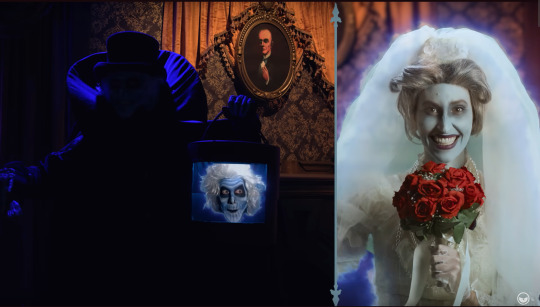
You can't have one of your members dress up as the Hatbox Ghost for a Haunted Mansion style video and not feature the character's main "gimmick" of his head moving from his neck to the box that he holds! And well, all things considered, Voiceplay did a pretty decent job of it! (And hey, even Disney themselves struggled with it - the character was removed from the attraction within only a few weeks of the ride's opening, and didn't actually return to the ride until 46 years later, in 2015, for the park's Diamond Anniversary Celebrations!)
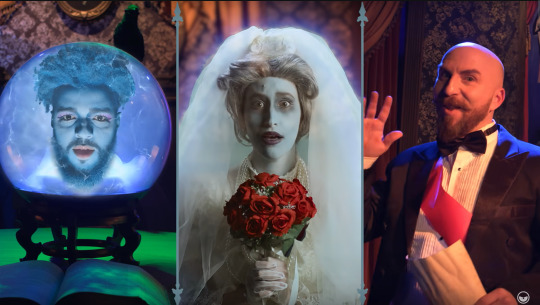
"Knock, knock, I'm inside your room now" "Hello!"

Voiceplay are just showing off at this point honestly 😝 (I wonder how long this video was in production for? Seems like it would have been a big project taking at least a full month, if not longer)
Also haven't yet mentioned it but it's cool how the full group shots are shot in a way that makes it look like you're watching this from one of the ridecars (people-movers?) of the Haunted Mansion!
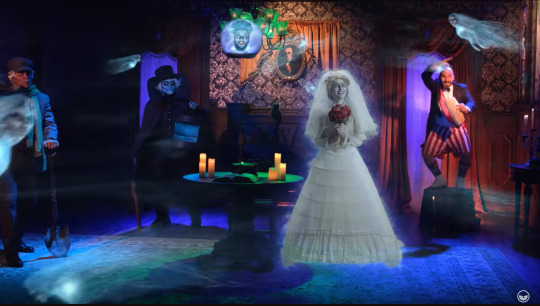
Oh dang I completely forgot about Cesar's/Madame Leota's crystal ball floating up in the air!
And there you have it folks! Maybe not one of my most picture-heavy posts, but quite possibly one of the most text-heavy! Now time for me to not watch this video again until October at the earliest!
(Also, since I'm skipping over the Christmas videos (for now at least), we're finally into the 2023 bunch of videos! (Though I'll be skipping over Nothing Else Matters and In My Room, sorry!))
#voiceplay#acapella#hide and seek ding dong#hide and seek vocaloid#geoff castellucci#eli jacobson#layne stein#cesar de la rosa#lauren paley#acaplaya analysis#voiceplay visuals
9 notes
·
View notes
Text
FIRST SOCIALITE (HUSBAND): “I can’t read this thing!” (Tossing aside Truman Capote’s magazine excerpt from his forthcoming novel Answered Prayers.)
SECOND SOCIALITE (WIFE): “But darling, you must read all of it. If you don’t, we won’t have anything to talk to anybody about.”
The above exchange actually occurred, but as often happens with popular hot controversies, the principals prefer not to be identified, even after telling the tale on themselves. The social stakes are too high. Being on the wrong side in one of these tempests in a teabag could be fatal. What if Kitty Miller never invites you again … or “Swifty” Lazar hangs up on you … or the Bill Paleys hear you didn’t step over the line at what has now become the Smart Set’s own Alamo? Or what if Truman Capote prevails and comes out on top? What if he writes a sequel that tells even more?
Staying alive and well in society means never zigging when you should zag.
“Whoever gossips to you will gossip of you,” goes the old Spanish proverb, and this one came home to roost for the International Set’s crème de la crème with the publication in the November Esquire of Capote’s “La Côte Basque 1965” — the “tail” of the long-awaited “kite” called Answered Prayers that is the writer’s next major work of fiction.
Society’s sacred monsters at the top have been in a state of shock ever since. Never have you heard such gnashing of teeth, such cries for revenge, such shouts of betrayal and screams of outrage. Well, anyway, not since Marcel Proust flattered his way into the salons of the Faubourg St. Germain and then retired to a cork-lined room to create a masterpiece, recalling the details of the Baron de Montesquiou’s “preciosities” and rendering him into the “Baron de Charlus,” setting down the vivid details of a world of le gratin where the rich see only one another.
What did Capote write that so enraged so many? Oh, just everything he ever heard whispered, shouted, or bruited about — the same kind of stories that have been wafting among the fine French furniture crowd since Maury Paul first saw the Blue Book dining out on Thursday and coined the phrase “Cafe Society.”
“La Côte Basque 1965” is a 13,000-word story about a luncheon between “Lady Ina Coolbirth,” a 40-ish multiple divorcée on the rebound from an affair with a Rothschild, and the innocent narrator, “Jonesy,” at Henri Soule’s exclusive Manhattan restaurant. While drinking Champagne and eating a soufflé Furstenberg, “Lady Ina” gossips about the International Set, telling one “no-no” after another on one and all, including herself. Capote has peopled his story with real persons, using their real names as well as with a number of other real persons, using fake names. The most shocking of “Lady Ina’s” send-ups are the stories about Cole Porter putting the make on an Italian waiter called “Dixie,” the one about “the governor’s wife” and her sordid sexual put-down of the climbing Jewish tycoon “Sidney Dillon,” and the histoire of trashy “Ann Hopkins,” who tricked a blue blood into marriage, then murdered him after he got the goods on her and threatened divorce.
Other naughty things in the story are the opening dirty joke … the bad breath of Arturo (Lopez Wilshaw) … the duchess of Windsor never picking up a check … Maureen Stapleton’s nervous collapse … Carol Matthau’s dirty mouth … Princess Margaret’s dislike of “poufs” … Gloria Vanderbilt’s failure to recognize her first husband … Oona O’Neill fluffing off the boyish J.D. Salinger … Joe Kennedy having his way with an 18-year-old school chum of his daughter’s … “Sidney Dillon” and his womanizing and social climbing .. . “Cleo Dillon” loving only herself .. how the famous TV comic “Bobby Baxter” goes off with a hooker and his pushy wife, “Jane,” has the last laugh … the weird young movie cutie who marries the son, then the father, only to find herself divorced because of a German shepherd … Lee Radziwill coming off better looking than Jackie Kennedy, who resembles “a female impersonator” … the love affairs of “Lady Ina,” how much she needs a man, and her envy of the domestic bliss of two attractive lesbians who reside in Santa Fe, “the dyke capital of the United States.”
Capote insists that the gossipmongering central character, “Lady Ina Coolbirth,” is strictly an invention — but friends of Lady (“Slim”) Keith, Pamela Harriman, Carol Portago, and Fleur Cowles are all nevertheless incensed. “Well,” sniffs Truman, “let them all martyr and identify themselves if they like … let them hang from the cross claiming they’re hurt … those who want to say they are models, that’s up to them!”
Other characters in “LCB ’65” are so thinly disguised as to be seen through tissue paper clearly — among them “Ann Hopkins,” undoubtedly representing Mrs. William Woodward Jr., who killed herself on October 10, seven days before Esquire hit the stands, and “the governor’s wife,” said to be the late Marie Harriman.
Many other names were dropped, some in passing, some to devastating effect. John Hersey has said that “the final test of a work of art is not whether it has beauty, but whether it has power.” But try telling that to the friends of the late Cole Porter, or Maureen Stapleton, Elsie Woodward, Josh and Nedda Logan, Johnny Carson, “Babe” Paley and her powerful husband, Bill. (I remarked to Truman that I didn’t know that his now ex-friend Mr. Paley had ever been an “adviser to presidents,” as “Sidney Dillon” is described in the piece. Truman just grinned and said, “I didn’t either.”)
Everybody written about in “LCB ‘65” has been guessed and second-guessed at with little or no concession to Capote’s own thesis — that this is a fictionalized version of a world he knows very well.
For years Capote has been society’s adored and adorable resident intellect and court jester. In a world where parties are still often “given against someone” … where bitchery, snobbery, and hauteur are still prized right along with poise, manners, and money … where the merits of plastic surgeons are argued in the same way the religious used to argue theology — gossip has always been the great staple, the glue holding beleaguered life-styles and sinking social values together. But it’s one thing to tell the nastiest story in the world to all your 50 best friends; it’s another to see it set down in cold Century Expanded type.
Capote has always been the gossip’s gossip nonpareil. He has been leaving them laughing and quaffing blanc de blanc with the best of them, ever since he came of age as an enfant terrible pet of the rich after Other Voices, Other Rooms catapulted him to fame in 1948. He has sailed on their yachts, masterminded their love affairs, and been such a focal insider that his Black and White Ball for publisher Kay Graham is still remembered as one of society’s best parties.
When the gorgeous women of the world’s tycoons and power brokers sat down to spoon up soufflé with Capote, or when Truman tickled the risibilities of the powerful tycoons themselves with his outrageous tidbits and fascinating possibilities, he was always the brightest, most entertaining little imp imaginable. Oh yes, of course, he was — well, everyone knew, “queer.” But in such an amusing classy way — in the manner of the great Italian count who remonstrated with an English lord for snobbery, saying, “My dear fellow, when your ancestors were still painting themselves blue, mine were already homosexual!” You know, that sort of thing. And then, of course, didn’t that more or less make dear “Tru” all the more manageable and “safe”?
Society always thought it had something on Capote, in the same way the French le gratin had Proust’s desperate desire to belong, his suspected inversion, and his Jewishness on him. What’s more, society believed Truman to be a lightweight climber who aspired to stay in its good graces. (Snorts Truman, “Yes, they have always made that mistake about me! Why, if anybody was ever at the center of that world, it was me, so who is rejecting whom in this?” Summoning up an echo of Beau Brummell’s “In society stay for just as long as it takes to make an impression. After that — go!,” Truman continues: “I mean I can create any kind of social world I want, anywhere I want!”)
It seems simply never to have occurred to many people that the writer’s goddess might turn out to be not “Babe” Paley, but Truman’s own muse. He was, after all, so seductive, so naughty, so charming. He knew everything about everybody and — what’s more — had total recall. But now, the same people who listened so delightedly and told tales out of school find themselves hoist by their own windiness. There they are, splashed through the pages of Esquire like hollandaise that has missed the asparagus. God! And that ain’t all — there’s more to come. It is all going to be bound between hard covers into a book. A book!
Capote, meanwhile, is also a literary name. The almost universal acclaim for In Cold Blood lifted his reputation from that of a poetic mannerist into the pantheon of American belles lettres. So the Establishment world that reads and writes has also joined the hue and cry. The question whether Capote has indeed ruined his reputation by stooping to writing gossip, as opposed to whether he is only doing the same kind of work attempted by ether famous writers in the past, will be argued for a long time. There seems to be no such thing as an indifferent opinion of “LCB ’65.”
Feuds and furors flash and die in these media-mad days, but the roar over Capote’s roman á clef vignettes, observed and recorded in explicit detail, rages on. “LCB ’65” was a one-shot last November, but its reverberating ripples still lash both coasts.
(Capote yelps: “When I was in New York a few weeks ago everybody was falling all over themselves being nice to me. The machinations going on behind the back of the people who are in the book you wouldn’t believe. Most of the attackers are just pilot fish, trying to outdo one another in being vicious in their sycophancy. They all want to stay in my favor but maintain a great front of animosity.”)
Capote rushed back to California from New York to finish up another 30,000-word installment for May publication. The reaction to “LCB ‘65” inspired him to crank that up to 40,000 words, and now, he says the literary Establishment can sit around waiting for their turn. They are “on” next, and then there’ll be four more magazine assaults before Answered Prayers appears in hardcover.
Dissenters to what one social Don Quixote calls “Capote’s character assassination in the guise of art” have been pellucidly vocal: “Disgusting! It’s disgusting!” says society’s favorite extra man, real-estate investor Jerome Zipkin, shooting his immaculate French cuffs. “Truman is ruined. He will no longer be received socially anywhere. What’s more — those who receive him will no longer be received.”
Patrick O’Higgins, a writer and pal of Elsie Woodward — the mother-in-law of the late suicide, Ann Woodward — is himself one of the more exquisite tale-tellers of this same world, but he says: “Truman’s gone downhill. People think, ‘What a shame that a great talent should be reduced to writing gossip.’ Some people are really hurt because they’ve been kind to him. The Paleys were always so fond of him. But Elsie hasn’t been hurt. She didn’t even read the piece. She couldn’t care less. All she’ll say is ‘Je ne le connais pas!’ — isn’t that perfect?”
Columnist Jack O’Brian: “He knows what will sell in this market … he’s Jackie Susann with an education.”
Writer Wyatt Cooper, husband of Gloria Vanderbilt: “I hate talking when my feelings are negative. It isn’t constructive. I’m very fond of Truman. We used to have lunch, gossip, and it was fun. But lately it wasn’t. His viciousness ceased to make it fun. I even talked to him about it two years ago and he thanked me later for caring. I think this destroys all the things he has built up. He can’t really pretend to sneer at these people in the Jet Set. He worked too hard to be ‘in’ himself. Of course Gloria is offended! He made Carol Matthau come out tough and bright, but has Gloria looking vapid and dumb, in a very unfair way.”
Wyatt, who collaborated with Truman on a television project and has known him for years, continues in his “more in sorrow than in anger” vein: “I had always wanted Truman to write a truthful, non-idealized version of his painful and strange childhood as an outsider. It could have been great. But, you know, he has always had a love-hate for all these beautiful women he has been close to. His mother was an alcoholic and killed herself, and children of alcoholic mothers often end up attacking women. Truman would like to be glamorous and beautiful. He has often acted out fantasies of his own by telling his women friends how to act, who to have love affairs with, by manipulating them. Now he has his ultimate revenge, by making them ridiculous in print.”
Gloria Vanderbilt: “I have never seen it and have heard enough about it to know I don’t want to.”
Director Peter Glenville: “Ignoble, utterly ignoble!”
Esquire’s own media critic, Nora Ephron, who didn’t even like the mild version of reminiscence and revelation dished out by Brendan Gill in Here at The New Yorker: “There has always been a disparity between Capote’s fiction and the public personality, and now finally the two have come together and the public personality has won.”
William and “Babe” Paley are said to have now instructed their distinguished relatives to the effect that longtime pal Capote is persona non grata. And society’s favorite current story is of how Truman phoned Paley to ask what he thought of “LCB ’65.” Paley reportedly said, “Well, I started it and dropped off to sleep and when I woke up, they’d thrown it out.” (Zing!) When Capote protested that it was important that Paley read it, his old friend said wearily, “Truman, my wife [get that — “my wife,” not “your friend Babe”] is ill. I really haven’t time for it.” (Zowie!)
Truman found Wyatt Cooper unable to lunch with him when he was in New York over the holidays. (Cooper: “How could I — out of loyalty to Gloria. She says she’ll spit at him if she sees him.”) And Capote tells of being “cut” in Quo-Vadis by “a pitiful old society woman I often took about in Paris because I felt so sorry for her. No, don’t mention her name — it’s too sad.”
Mrs. Josh Logan was said to be so incensed she rushed across a crowded room to call Dotson Rader a “traitor” just because he also writes for Esquire. Nedda Logan informed Dotson that “that dirty little toad is never coming to my parties again.” (Some dialogue in “LCB ’65” refers to a Logan soirée: “‘How was it?’ — ‘Marvelous. If you have never been to a party before.’”)
Then there are the artful diplomats, like those two brilliants who’ve won fame straddling the fine line between practicing journalism and personal social acceptance among the Upper Crust — yes, fashion’s elegant Diana Vreeland, as well as that friend-of-the-“400” (sometimes now referred to derisively as “the 4,000”) Aileen (“Suzy”) Mehle. Told that Truman wanted to know why she had never written so much as a word in her syndicated society column about the only subject consuming “her crowd” since November, Suzy says: “Why? Why, there’s nothing for me to write. Truman’s done it all himself!”
And Mrs. Vreeland (rising high above the smoke of controversy just as a perfect hostess ignores a cigarette in the butter) dismisses the gaudy gossip, the sex scandals, the barely concealed identities, the homosexual revelations, the obscenity, the accusations of murder, and the matter of whether or not Capote has been “antisemitic,” “anti-gay,” and/or “disloyal” to friends and playmates, by putting one unerring finger on just what she considers important. “Yes — yes! The paragraph on the fresh vegetables and their size is really unique in the article. It’s a ravishing statement on the rich!”
Then there are the happy cynics like Emlyn Williams, distinguished Welsh actor-writer: “It was terrible, just awful, but it was so funny-riveting. I couldn’t help laughing.”
Then there are the defenders of Art. Rust Hills, a former fiction editor: “Fascinating stuff. Yes, of course, it’s okay he published it all. I think the artist does have a supreme right to use any material. Remember, life is short but art is long” … Painter David Gibbs: “Oh, don’t be absurd — all art is revolution! Why can’t people get that through their heads? This is brilliant stuff!” … Dotson Rader: “Marvelous, beautiful writing. It’s unimportant whether it’s true or not, since it is presented as fiction. Truman was always treated by these people as a kind of curiosity, expected to do his act. That was humiliation coming from people who had no qualifications other than being rich and social. Everybody in the world has been telling Truman their deepest confidences for years and he never said he wouldn’t use them.” … Geraldine Stutz, a woman of fastidious opinions: “It’s only a scandal to a small insular world; most people won’t know, and couldn’t care less about who might be who. What counts is that it is a wonderful piece of writing and an extraordinary re-creation of the tone and texture of those days in that world” … C. Z. Guest: “Everyone knows the man’s a professional and they told him those things anyway. He’s a dear friend of mine, but I wouldn’t discuss very private matters with him. I don’t even know who those fictional people are.”
Screenwriter Joel Schumacher, himself one of the Beautiful People: “If Truman had written a glittering vision of society, he’d have been termed an ass-kisser and his work a piece of crap by these same people. They always want some candy-ass lie written about themselves. This same world thinks it supports art and artists, but never understands that all a writer has is his experience. These people feel a good press is owed them. Why? In the fame-and-fortune game, whether it’s society, show business, big business, or politics, everybody lives on a plane of incomparable elitism, more money, more privilege than others. So why are they so shocked when somebody tells even a slightly unattractive truth about them?”
So, speaking of Beautiful People, the night before flying to Los Angeles to interview Capote I’m at Pearl’s with seven of them (or what I call semi-B.P.s, in that most of these work hard yet are still “social” enough to be written about and invited everywhere). After the lemon chicken has been served and Pearl has stopped clucking over us, the question goes: “What’s the one thing each of you would like to know from Capote?” They told me.
In this gathering, these youthful realists were amused and entertained by Capote’s daring. Most of them thought the writing was important. Only one of the seven Beauties completely disapproved of the piece. This Frito-colored hair and the women with was the most “social” — by whatever terms — person there; also the richest: a person who found “LCB ’65” “disgusting, unnecessary, mean, bitchy, Truman, like some Napoleon on spiteful, disloyal, and not even very well written.”
General laughter and the retort: “We’re sorry you can’t express yourself more definitely.” But such dissenting opinions were in the majority in the weeks to come. And always, the final clincher by Capote’s detractors was that this hideous, disloyal, tasteless thing the writer had done was bad enough in all its aspects, but its chief minuses were that it was “boring” and “wasn’t even well written.”
A society that habitually enfolds ennui and stinging cultural criticism around its shoulders like a familiar sable wrap could make such pronouncements and still not talk about anything else for two solid months.
Beverly Hills: La Côte Basque 1965 may have been a place, as Esquire noted, “where the plat du jour is seated somewhere in sight,” but La Scala, late 1975, is a place where Henri Soule probably wouldn’t have sent his enemy Harry Cohn. La Scala’s food is indifferent and its service based on benign neglect, yet it offers a carelessly cultivated charm and ambience of New York–in–California. Once inside, out of the relentless 73-degree sunshine, away from the gas-fed fire burning in the Beverly Hills Hotel lobby, away from the denim-tailored suntanned men with Frito-colored hair and the women with smart-looking Mark Cross–type bags that read “Bullshit,” a person can almost imagine being in New York.
Truman, like some Napoleon on Elba yearning for the East (I fancy), suggests we meet here. He has a day off from his acting role as the portly eccentric who lures facsimiles of the world’s most famous detectives to his mansion for sinister purposes in Neil Simon’s movie Murder by Death.
Enter reporter, tape recorder cocked, to find Truman talking with the departing screenwriter Peter Viertel. We slide into a booth and Truman, looking more and more like a diabolical version of the character actor Victor Moore, says nix to the recorder. “I’ll have more to say if you don’t use it.” I protest that I haven’t his fabled total recall. “Oh, you’ll do all right. You’ll see, you’ll get a better story this way.”
Already the interview is out of my hands into the subtle control of Capote. Only around Truman do I ever feel a real kinship with those glamorous women like C-Z, Jackie, Lee, Gloria, Carol, Slim, Babe, Kay, Fleur, Pamela, etc. He inspires a compelling intimacy. I begin to tell him everything. I spurt confidences, betray my instincts, and allow myself to be drawn out. For each question I ask, Truman asks two. “Seductive” is how one longtime friend described Capote, and she is right. I cling to the edge of the table to keep it from turning completely.
Then he orders a double Russian vodka with no ice and a tall orange juice on the side. Oh well, that makes me feel better. If he’s going to drink like that, I’ll be okay. (When the interview ends, two double vodkas, a half-bottle of red wine, and four J&Bs on the rocks later, Truman is as fit as ever and I am still in his power.)
Truman answers the questions put by Pearl’s diners. He punctuates his softly drawled, easily imitated, and widely recognized vocal mannerism with bursts of irrepressible laughter. And some amazed and genuine outrage. He begins most of his sentences with a drawn-out “W-e-e-e-l-l-l…”
WHY DID HE DO IT? WHY GO QUITE SO FAR? asked the retailer.
“Why did I do it? Why? I have lived a life of observation. I’ve been working on this book for years, collecting. Anybody who mixes with a certain kind of writer ought to realize they’re in danger. [Chuckle.] I don’t feel I betrayed anybody. This is a mere nothing, a drop in the bucket. To think what I could have done in that chapter. My whole point was to prove gossip can be literature. I’ve been seriously writing this for three and a half years. I told everybody what I was doing. I discussed it on TV. Why has it come as such a great big surprise?”
IS THERE REALLY MORE COMING, OR IS THIS ALL? THEY SAY YOU CAN’T FINISH THE BOOK, asked the fashion arbiter.
“This thing was only a chapter. My God, what will happen when ‘Unspoiled Monsters’ comes out? [Don’t you like that title?] I’ve never before heard it suggested that this wasn’t part of a whole book. Even my ‘Mojave,’ published in Esquire before this, was part of Answered Prayers, though we didn’t publicize it as such. ‘La Côte Basque 1965’ is certainly no short story. Of course it’s a book! [Exasperation.] Lord, I have a lot to say, baby! I haven’t even begun to say it, though the book is 80 percent written.”
IS IT TRUE YOU ARE DYING OF CANCER? asked the art dealer.
“Irving Mansfield likes to go around telling everybody I’m dying of cancer, but I’m well now. Oh, that reminds me of a story.”
Truman cocks his platinum head so I get a good view of his flat baby-pink ears, which seem to have come in a child’s size and never grown.
“When Jackie Susann died, the Times called me for a quote. I was reminded of a judge who once ruled against Father Divine in some property dispute. Later the judge dropped dead of a heart attack and when they asked Father Divine to comment, he said, ‘I hated to do it, but …’ “
Capote explodes with roars of laughter that rumble up out of his ample belly into a series of hah-hah-hahs. “So I just told the Times, ‘I hated to do it, but …’”
DID YOU WRITE THIS JUST TO MAKE MONEY AND TO SOCK AWAY SOMETHING FOR A LOVER, AS THEY SAY? asked the producer’s wife.
“I have never in my life done anything just for money. I’ve never had any reason to. Why would I need money? My God, I made over $3 million from In Cold Blood and I haven’t spent it. I sure haven’t made any money out of ‘La Côte Basque 1965.’ That’s absolutely cracky! You know you don’t make money from magazines.
“As for my personal life, I don’t care what anyone says or writes about me personally. I have been a public exhibit all my life. So let them go ahead and make me a monster. I was a beautiful little boy, you know, and everybody had me — men, women, dogs, and fire hydrants. I did it with everybody. I didn’t slow down until I was 19, and then I became very circumspect. But everybody knows where everybody else is sexually. There are no secrets, and that’s why I don’t understand the shocked response to ‘La Côte Basque 1965.’ What is all this business? Are these people living in some other medieval century? I’d never sue anyone for anything, but I’ve been lied about my whole life. I’m just surprised they don’t hire a hit man.”
We stop to order. Truman has steak sliced thin as prosciutto, special mayonnaise, fettuccine Alfredo, and Brie. He is emphatic that he won’t be driven out of New York or sell his U.N. Plaza apartment. (“No, no. that’s not so.”) Nor has he bought a house in Topanga Canyon. (“I guess they think that because that’s where the Manson family lived and I’m a monster, too.”) I notice a slight tremor to Truman’s tiny hands as he lifts his glass and feel a pang for his strain.
WERE YOU TAKING REVENGE FOR ALL THOSE YEARS IN SOCIETY, LIKE A PET DWARF KICKING THE ROYALS IN THE SHIN AT LAST? asked the WWD biggie.
“I didn’t mean anything vengeful, not even remotely. And I’m disappointed in these people, with all their pretensions for reading, art, theater, and culture that they’re so stupid and can’t see it as a work of art. This book is a serious work of art — if you don’t see it as that, then you don’t see it as anything. I’ve always done good things. Would I actually sit down and write about something like that as a joke, as revenge?”
I ask, “But didn’t it really occur to you that you’d be called a traitor and disloyal for publishing this specific kind of work, using people’s names?”
Truman sighs: “Well, it is true nobody likes what you write about them. Even those I was sympathetic to in In Cold Blood didn’t like themselves in print. Loyalty wasn’t the question, but on the other hand, I don’t care. I really don’t. If that’s the mentality — tant pis … I haven’t lost a single friend I’d want to keep in any event. These people saying these things weren’t friends of mine to begin with. Nedda Logan has always hated me, ever since I published that Brando piece in The New Yorker. What do the Logans have to do with anything, just because they once gave a party for Princess Margaret, who everyone knows is a terrible bore!”
IS IT TRUE ESQUIRE LAWYERS SHOWED THE “ANN HOPKINS” PART TO ANN WOODWARD FOR LEGAL CLEARANCE AND, RECOGNIZING HERSELF, SHE KILLED HERSELF? asked the designer.
“The most vicious thing about all this is that story! It’s absolutely untrue that Esquire showed her the copy. That’s ridiculous. Of course nobody showed it to her, as it would have been tantamount to admitting it was about her. I never let anybody read it in toto, and that’s why it was impossible for her to have seen or heard of it. The manuscript was kept in a bank vault. I was very careful with it; sometimes I let a few people read part of it with me sitting there. The new portion, ‘Unspoiled Monsters,’ I’ve never shown to anybody. This book wanders in all directions. It’s not just about the ‘Côte Basque’ people, and my God, of course I’m not taking out after Babe Paley in the next part. She isn’t even mentioned. How do these things get started? The book is really about ‘Kate McCloud.’ And nobody but me knows who she is, and nobody is going to know.”
I tell Truman that Elsie Woodward herself does not feel Ann committed suicide for any reason having to do with him. He says, “You see …. “
DON’T YOU CARE THAT ALL THESE PEOPLE ARE GOING TO CLOSE THEIR DOORS TO YOU? asked the play producer.
“Well, in the first place, I don’t think all these people will. I maintain the people who are really mad are the ones left out. Jean vanden Heuvel said, ‘I hope it isn’t true I’m not going to be in by name. “La Côte Basque” was delicious and I hereby propose myself for another section.’
“Look, I’m not using Proust as a model because what I’m doing is in the latter half of the 20th century as an American. But if someone like Proust were here now and an American, he’d be writing about this world. People say the language is filthy. I think that’s the way people talk and think now — exactly. I think it’s beautifully written. This thing about me never being invited again just shows such an ignorance of human nature that I can’t believe it. People don’t understand how their own minds work. No matter what happens, you have to respect somebody because he is an artist, if you have any pretensions to culture. There’s a fantastic ingratitude in America toward its artists. I mean, you do marvelous things and they just …
“Well, France is loyal to its artists, England to its artists, even Russia to its artists [chuckle], when they are dead. No other country treats its creative people like we do. Here they wait for you to fail. They love it. If people think I’m just a bitch, then I surely am 100 percent misunderstood. I consider myself a fine artist. I drove down here from working in British Columbia to start work on the movie and found the world had exploded. This place has been in the same uproar as New York.”
I say that maybe people in Hollywood are afraid they’ll be next.
Truman laughs. “Oh, they’ll get theirs!”
He turns serious: “Look, my life has been dominated by my own levels of taste in art, especially the art of narrative prose writing, wherein my particular art lies. I have never compromised that. I may have compromised other things in my life, personally, emotionally, or whatnot, but never that. This book, this whole thing, has been the ultimate of my art. You have to be true to your work. I’ve always said there’s no such thing as writing down. Writers always do the best they can.”
We go out into the sunshine. I take a good look at Truman and am infected perhaps by his own line describing Henri Soulé as “pink and glazed as a marzipan pig.” We walk toward the Beverly Wilshire while I think only in food clichés. I note Truman’s new butter-colored moccasins … his apricot-yogurt sweater … his Champagne lick of hair … the strawberry-colored heels of his tiny French carroty hands … his pale raspberry-tinted sunglasses … his soft Cardin hat with its gingerbread texture. l’m relieved to see that he is wearing an ordinary unappetizing pair of trousers that make him look as if he has been hit in the ass with a shovel.
Truman carries his current overweight bulge before him like some defrocked Santa Claus. He gives several autographs en route. He tries to buy a denim vest covered with pockets, discovers that an expensive camera comes with it, and shrugs, “They should give it to me.” At the hotel we fall into the El Padrino bar and Truman asks for a telephone. Disturbed by reports of Diana Vreeland’s displeasure, he dials her direct.
He calls her “darling,” “angel,” “precious one,” and tells her twice that he loves her. He hangs up triumphant and exclaims: “She says it’s the only important and interesting thing she has ever read about the rich!”
Burbank, Stage 15: I am watching Truman “act.” He stands on a step ladder reading Murder by Death lines in a singularly hideous dining-room set. Peter Sellers, Elsa Lanchester, and Timmy Coco play the scene with him. As far as one can see, Capote makes no effort to “act” but simply plays himself. When the heavy chandelier falls, smashing the table and almost causing serious injuries, Capote quips: “The ghosts of Gore Vidal and of Jackie Susann, no doubt.”
In his mobile dressing room, I ask about this acting bit: “Oh, I just thought it would be fun to do something different and I really liked the script. It’s going to be a good movie. I probably won’t act again. It was just for a change from working on the book, and I knew I didn’t have time to take a vacation. How am I as an actor? [Chuckles.] Let’s see, just say, ‘What Billie Holiday is to jazz … what Mae West is to tits … what Gucci is to loafers … what Schlumberger is to enamel bracelets … what Cartier is to tank watches … what Guerlain is to perfume … what Roederer is to Champagne … what Chekhov is to the short story … what Seconal is to sleeping pills … what King Kong is to penises, Truman Capote is to the great god Thespis!”
Truman is suddenly struck by an idea. “My agent Mr. Irving Lazar has given several parties of late and didn’t invite me. So maybe you’re right. Maybe I am a social outcast. Tell you what — call him up and ask about it!”
I’m reluctant, but Truman pays no attention to me. He gets Lazar’s phone number, he dials, and hands me the telephone. I give my message to the secretary, who says “Swifty” will call back. When I hang up, Truman is exasperated. “No, that’s not what I want you to say.” He re-coaches me in my lines. Before Lazar can return the call, Truman is called to the set. When the call comes through I tell Lazar that his client is now a social outcast and ask if this applies in Hollywood, since Truman has not been invited to Lazar’s parties.
Lazar says, grimly, “I wouldn’t have any comment about that.”
Floundering, I say, “You wouldn’t have any comment?”
Lazar: “No.”
I stumble, “Okay, well, I’ll tell Mr. Capote what you said.”
Lazar’s voice rises. “I didn’t tell you to tell Mr. Capote anything.”
“Yes, I know,” I reply, weakly, “and I will tell him that you say you have no comment.”
Lazar screams: “I don’t want you to tell Mr. Capote I said anything. Dammit, I knew I shouldn’t have taken this call!” (Slam.)
Truman loves it. He roars over having discomfited the agent of Richard M. Nixon. Two weeks later he calls New York to ask what people are saying now. I sense that he is anxious. He speaks bitterly of what he calls “the ‘walkers’ … my vociferous critics … what do they have to do with me … with my work?”
Soon it comes out that now the Paleys, the Whitneys, Gloria Vanderbilt, Mike and Jan Cowles, others who were indeed real friends, have drawn the line against Truman. Unlike the Baron de Montesquiou writing to Proust for reassurance that he is not the model for “Baron de Charlus,” Lady Keith does not get in touch with Capote at all. No, she has gone on a trip to the South Pacific with — the Irving Lazars.
Where does all this leave our hero? “Well, I won’t retire to my cork-lined room yet,” says Truman. “I’m just going to a Palm Springs spa to take off 20 pounds before a college lecture tour. Then I’ll drop the other shoe.”
I remind him that nobody can really judge a literary work for 50 years. “This won’t even be dated in 50 years!” says Truman with a bulldog tenacity.
Then I tell him the story of how Gertrude Stein, with all her artistic pretensions, didn’t like the portrait Picasso painted of her and made the classic hick comment: “But it doesn’t look like me!”
Picasso then said, “But it will!”
Truman applauds. He says, “You know. I’m beginning to think what’s happening now is better than the book!”
7 notes
·
View notes
Note
Visited Groningen last week I was just in time to spend my money on the May fair. lol Do you have cities you'd recommend to visit next or any NL attractions for that matter? Also, stroopwafel... my beloved..
Got this ask right after someone else's ask about visiting the Netherlands, lol.
You can't visit the Netherlands and not visit any art museums. You've got Rembrandt, Vermeer and Van Gogh in Amsterdam (Rijksmuseum, Van Gogh museum), Mondriaan, M.C. Escher and more Rembrandt and Vermeer (Girl With a Pearl Earring) in Den Haag (Kunstmuseum Den Haag, Escher in Het Paleis, Mauritshuis) and other amazing art musea with many of the Dutch masters (Kröller-Müller Museum, Rembrandthuis, etc.).
If you enjoy architecture, there's obviously Amsterdam (boat tour right outside the train station is pretty fun), in Rotterdam you'll find the cube houses, and there are the Delta Works in Zeeland. If you want to visit 'older' cities, you should definitely see Maastricht in the south, one of our oldest cities (and my personal favorite, but for heavily biased reasons, though it's really got a great atmosphere and beautiful buildings and goes right over the river the Maas). In Drenthe you'll find the 'hunebedden' (dolmens), tombs from prehistoric times. As far as castles, we have palaces like Soestdijk Palace and Het Loo and old castles like Muiderslot. Den Haag is also where our government resides, if that should interest you. Personally, I'd say these sort of things aren't really worth an entire trip by itself, unless you're truly interested, but more of a fun thing to check out if you should be visiting any of these cities anyway and have an extra hour to fill.
As far as nature goes we have the Veluwe in Gelderland, a wooded area. Go to Scheveningen if you want to visit the North Sea (also has a Sea Life aquarium). The beach is popular in summer but really I think it's nicer to visit on a cold day, when all you hear are the seagulls and the waves. The northern islands are nice places as well for quiet, beachy surroundings. You're just a month too late for the Keukenhof unfortunately, the world's largest tulip garden.
Lastly, you really should visit the Efteling, a theme park in Noord Brabant with a very unique style, full of fantasy elements and animatronics, including a fairy tale forest with lots of old-fashioned fairy tales (i.e. the originals, not the Disney versions). But also roller coasters and water rides and shit. Though if you mainly want roller coasters, I'd suggest Walibi instead (previously a Six Flags park).
Ever had fresh stroopwafels from a market stall? That shit is the best. I think it's more common in winter. The Efteling has a Winter Wonderland theme going on too then, with lots of stalls serving hot snacks and drinks. Maastricht also does yearly winter markets with ice skating, a huge ferris wheel and tons of stalls with hot glühwein and warm snacks.
Hope that gives you enough ideas lol.
7 notes
·
View notes
Text
This video takes a video created by Nina Paley and changed shortened it and added a different song to it.
But the original was created by Nina Paley.
Now who is a Nina Paley. She is a terf.
she stated that when referencing transgender people, she does not necessarily use the pronouns that the person uses. She said, "If a man uses 'she' pronouns… I'm adamant that he is free to identify as he wants. But we're also all free to identify things how we perceive them."
She is also in my opinion an antisemite. She created a film called Seder-Masochism.
After Sita Sings the Blues, Paley was criticized by some observers for co-opting the culture of India as an outsider, an assertion with which she strongly disagreed. A recurring theme among the negative comments was "how would you like it if people made a film about your religion? Paley thought that she would enjoy watching any such film. Accepting this as a challenge, she turned to her own Jewish cultural heritage for her next project: a revisionist retelling of the story of Passover. She pored over the Book of Exodus, finding details that were not part of modern Jewish culture, for instance, that Moses's brother Aharon performed some of the acts that are commonly attributed to Moses, and that the Jews were killing each other during their 40 years "wandering" in the desert. For inspiration, she also read The Creation of Patriarchy by Gerda Lerner, and The Language of the Goddess by Marija Gimbutas. She concluded that the Book of Exodus represents the final defeat of goddess worship by the patriarchy that had been rising since the agricultural revolution.
In November 2017, Paley wrote that much of the project had been completed without a "coherent story", despite the attempt to tie it together in the loose form of a Passover Seder. She decided instead "to articulate the Exodus from the Goddesses' point of view", the goddesses who were at that time worshiped in Egypt as Hathor, Isis, Nut, Sekhmet, and others. This turned her film into a narrative "about patriarchy and the suppression of the Goddess".
That is just insulting and gross. And keeps pushing this tired old bullshit about Judaism being some Patriarchal evil religion.
Nina shows she has no understanding of Judaism as a religion or as a culture.
And I don't think she cares to. There are many Jews who are atheists and still very tied to the community and cultural identity of being Jewish.
Nina is not one of them.
So sure the video is fun, but a terf made the original so fuck it.
Sure the video is fun, but an antisemite made the original so fuck it.
Because no thank I want nothing from terfs and I want nothing from antisemites.
In the club
436K notes
·
View notes
Text
In 16 years of coughing up this blog to the seven of you, I don't think I've ever done this. And by this, I mean reprinting an email. But I wanted to reach out to Jon Landau, the seminal 60s-70s Boston rock journalist who left all that to help out a scuttling guy named Bruce Springsteen after he saw him in Cambridge, and send him something a friend of mine wrote. (Perhaps Jon Landau's most underappreciated claim to fame....he lived across the street from my parents in Lincoln, Ma for 20 years.) I managed to get the email of his assistant. Five minutes after I sent the thing, the assistant wrote back: "Hi Bill, send the piece...." Sometimes, things just work out. I've written billions of emails, like all of us. This one I'm proud of. Mangia.
My old Letterman colleague ****** gave me your email, so, by all means, blame her.
Let me run a few names and places by you, so I can establish ideally my credibility with Jon:
NAMES: BARRY TASHIAN (friend) The late CHIP DAMIANI (friend) The late ANDY PALEY (friend) RICHIE UNTERBERGER (who wrote lovingly about my older brother Tom's 1967 cult-legend prep school garage band, The Rising Storm) LENNY KAYE (who gave me an after-deadline blurb for my second novel, "Time Won't Let Me," inspired by my brother's band) And, of course, Dave, Paul Shaffer and Will Lee (who will all vouch for MY band, The Truants ("We play NOTHING after 1967"))
PLACES: The Rat Lucifer's Paul's Mall Where It's At Jonathan Swift's The Inn Square Men's Bar The Paradise (where The Rising Storm opened for The Lost and The Remains in 1999. Peter Wolf MC'd) and 125 Chestnut Circle, Lincoln, Ma. (where my parents lived for 25 years)
Okay, enough chit chat I am an old white writer (see "irrelevant, quite"), but I have a young writer friend, Billy Glidden of Holyoke, who sent me a recent magazine piece he wrote about him and his mother and their bond through Bruce. I found it beyond vivid and insightful. And, as someone whose own prose made such a galactic impression on me and my older brother, I thought Jon might be so moved as well.
I am pretty sure you get a few dozen of these emails a week. That noted, it would be great if you'd like me to pass the piece along.
Whew. As always, thanks for your shamelessly solicited interest.
Bill Scheft
1 note
·
View note
Note
ooooh shamelessly stealing from and answer to @ashipwreckcoast : top 5 poem lines?
god has cursed me for my hubris and my work is never finished! i think i'll do my top five lately, since my favorite lines are legion and we don't have time for all that (did you know i have a master's degree in poetry, a real thing you're allowed to have). i'm cheating with a few of these but i don't want to divorce some of these lines from their context:
"not everything is sisyphean. no one ever wants to imagine themselves as the boulder."
- from it is once again the summer of my discontent & this is how we do it, by hanif abdurraqib.
"there’s a gamut of galactic feelings felt on this planet—trillions & trilling, while i especially love that wild species of weepy: half sob, half snort, half snotbubbly gigglysads. i am partial to sad, bad math"
-from weep ode #99, by chen chen
"Death is the only cultural truth, because there are fake marriages every day, and even the rappers and their beef is cooked up in an office, in somebody’s pink cheeks. I know it’s just a movie, but I’m still afraid of what I see when I fall asleep."
-from a brief history of the present, by morgan parker
"that's my old man across the yard he's talking to the meter reader he's telling him the world's sad story how electricity is oil or uranium and so forth I tell my grandson run over to your grandpa ask him to sit beside me for a minute I am suddenly exhausted by my desire to kiss his sweet explaining lips."
-from here, by grace paley
"the sour smell of SSRIs acrid alignment, a bucolic balance for a city kid’s crutch"
-from untitled, by h.j.d.
7 notes
·
View notes
Note
People don’t want to admit that Riverdale isn’t doing well and that season 5 was their kill shot because it benefits them. It’s undeniable that Riverdale isn’t doing well anymore and it doesn’t have the audience power as it used to have. They used to dominate in the TCAs, PCAs and MTV TV & Movie Awards. I remember when Madelaide won Scene Stealer in 2018 against pretty well known actors so it really proved the voting power the show had. In 2019, the most awarded at TCAs were Avengers Endgame and Riverdale with them taking best show and Lili/Cole for actor/actress respectively. BAs like to argue "Riverdale started losing viewership on season 3 when those couples existed" like, of course it did, that’s the natural professing of shows when they get to the 3-4 seasons like any normal show but the drop was minimal and the public was there making noise and selling out Paley Fest. The drop was normal specially when Riverdale's highest peak was season 2 both in audience and public relevance, it doesn’t say anything about VA or BH likability with the public because BH was a big reason why season 2 because so successful. The last nominations for Riverdale were in late 2020 for Best Drama TV Show and Cole/Lili.
Like, we know by the nominations along that Lili and Cole (BH, by extension) acted as the face of the show in many of those awards so not only was separating them a big mistake but also season 5 was just terrible. You can’t blame the pandemic for it because a lot of shows blow up during pandemic because people were watching anything on streaming services and a lot of old shows went trending because of it. Riverdale barely trends in Netflix or social media, don’t get nominations anymore and the views are under 200K now. The other big show on Riverdale was TVD, the views dropped a lot when Nina Dobrev left but even they didn’t drop this bad when it was almost over – their season FINALE on 2017 was 1.9M views and remained consistently around the 700k-800k mark.

Anons, I hear you and I agree with you, but I also have messages like this in my inbox, should you be wondering if people really do think the show is doing fine:

The thing is, continuing this way, this show won't have a shelf life. The rewatchability is the thing it's not too late to protect now, so it has to be the priority. My recommendation to the show is to give the fans exactly what they want for the last season. The majority of fans, not the crazy antis that invade our inboxes.
And yes, the show is not doing well. This is just a fact. I've long said that some ebb and flow in the ratings is normal, and it is. This isn't ebb and flow. They went from 700k a year ago to not even 200k now. In total, they're down about a million + viewers from their heyday. They get no nominations for anything, sell out no fan conventions, and have disappeared off streaming. That's not normal ebb and flow. The show is dying, and it is absolutely taking everyone's career down with it. You can literally see that in the actors' upcoming projects.
20 notes
·
View notes
Text
From Weird Hollywood:
Each year, come this season, a certain Slim Aarons photo makes the rounds on Instagram. It features a bathing beauty floating in a pool, bobbing alongside metallic holiday ornaments. Behind her, three children play with the floating, shining orbs. And because it’s not Slim Aarons unless there’s an element of lavish frivolity, a Christmas tree emerges from the water, festooned with swags of aluminum-foil-colored tinsel and metallic bows. The tree is inexplicably anchored to the bottom of the pool, and at the highest point of the tree is a Christmas star, glinting in the California sun. Off in the distance is the Hollywood sign. It’s titled “Christmas Swim.
“The other day I was on Instagram and saw a comment saying, ‘That’s not Katy Perry. That’s Rita Aarons!’” says Mary Aarons, daughter of Rita (the subject of “Christmas Swim”) and Slim. “I shared the mix-up with my mother. She’s 90 years old and she’s with it, but she has zero social media knowledge and understanding. She always asks where am I seeing all this and who are these people who know about it. And I tell her, ‘You are sort of like an Instagram star.’”
Instagram is a funny place, a platform for anonymous individuals to launch themselves into the public eye and for the already famous to maintain their renown. On the gram, you get what you give, and so it’s peculiar for the app to have had such an impact on a nonuser. Slim wasn’t alive to see the invention of Instagram, and he doesn’t have an estate managing an official account, and yet Instagram has played a significant role in his legacy. Through Instagram, Slim’s photos are distributed, circulated, and double-tapped by users all over the world.
On assignment for Life, Town & Country, or Holiday Magazine—from the 1950s and well into the 1970s—Slim would ping-pong across the globe to cities only fashionable at a certain time of the year: Palm Springs, Verbier, Marbella. Those holiday playgrounds where the old-monied set clinked Champagne glasses with oligarchs of modern industry and pretty young things with Hollywood stars in their eyes. Slim photographed swank après-ski scenes in Squaw Valley and the photogenic patrons at Il Pellicano, but more than that, he was granted rarified access into private spaces of those whose fame was their fortune or for whom entitlement was a birthright—C.Z. Guest, Babe Paley, Princess Caroline of Monaco, Countess Dolores von Furstenberg.
In the winter of 1954, the attractive person doing the attractive thing in the attractive place was Lorita (or Rita), his new wife, formerly an assistant at Life, swimming beneath the Hollywood sign and a Christmas tree. The place was Los Angeles, California.
Few details are known about the festive photo, one of Slim’s most iconic, but Mary offers some context: “It was a hired house and hired kids, and my mom’s big recollections were that it was a really cold, really dirty pool and that because they wanted everything to line up just right (and obviously it was her husband taking the picture), he made her stay in there a really long time,” says Mary. “She was freezing and mad. It looks idyllic now, but to get it just right in a cold and dirty pool took a while.”
Mary estimates the photo session might have taken an hour or an hour and a half. “He didn’t use lights, and I would guess—I’m not great at perspectives but I’m looking at it now because I put it out every Christmas—he’s standing on the diving board or a ladder at the other end of the pool.”
“I’m not that old,” Mary jokingly asserts when asked about people thinking she was one of the kids in the picture. “I came around a couple of years later.” Who they are remains a mystery, as does the location of the house. Mary, who lovingly keeps up with all the latest discoveries relating to her father, tells me there’s a big debate on the exact address of the house. Though Los Angeles was a city Slim and his wife spent a bit of time in, the house was not one they ever occupied—simply a set that offered a marvelous view of the Hollywood sign. “A lot of people think it’s Baldwin Hills,” says Mary. “Somewhere, somebody does know where that house is. It doesn’t look like the kind of house that would still be there now. It’s probably been razed. But it works. It was a beautiful picture.”

3 notes
·
View notes
Link
"I think about what the Paley Center did for TV. Paley early on saw the TV industry was getting ready to literally throw away the tapes that these old TV shows were on, and he said, 'Hey, I want to archive those because at some point, somebody will want to go back and watch the Ed Sullivan show or something, and those things shouldn't be thrown away.' As an industry I would love it if we came together to help preserve the history of what our industry is about, so we don't lose access to some of the things that got us to where we are today."
Holy Shit a higher up In a gaming corporation who actually cares about game preservation.
Who would've thought Xbox would be based.
21 notes
·
View notes
Text
The Punishment of Red Herrings/Weak pay offs (Reader’s advice to writer series #1)
Warning: I am a reader, and in no way, shape or form a professional writer. But this is just my 5 cents. You probably think I’m overreacting on a 12 year old kiddie series, but like, my whole blog could be classified as that to be honest, and this is a fairly easy series to read, so that’s why it’s going to be my introduction into this ‘Reader’s Advice to Writer’ series.
Ok, so red herrings right? You know that little b8 that the writrs sometime like to throw in order to throw you off the scent of what’s actually going to happen? Yeah? It helps to make the stories less predictable and plot twists less unexpected- but Some people, love them. Some people hate them- which is fine.
Now let me start off by saying- contrary to popular opinion, there is nothing wrong with writing a predictable story, in fact predictability is a good thing as long as it’s sensible. Most writers would take a sensible predictable story, over a pointless plot twist that ruins the whole thing- just ask svtfoe, and star wars fans. Seriously- if you’re a good enough writer, it doesn’t hurt to have a predictable ending as the pay off still matters- remember that, ok?
Now, back to the red herrings, it’s not an inheritently bad thing to have a red herring in a story- what is bad, however, when said red herring is setting up for an ending that was far worse than the false ending it was actually teasing. Let me give you an example- let’s use some of the old Poison Apple Storybooks- for middle school girls, a nice little introduction into the world of supernatural for kiddies.
In particular, I want to focus on these 4 books- the first 3 books (and the 8th book) of the series that follows various 12/13 year old girls who experience the unnerving world of the supernatural




Now I wouldn’t be surprised if most of you who read these books thought they were pretty stereotypical- given how most of these girls are obsessed with fashion, always end up with a love interest who happens to be a super cute boy, and what not- but let’s cut the authors some slack, it was made to appeal to a fairly wide demographic, and I don’t think 12 year olds back then were too focused on being diffeent and breaking social norms, but I digress.
Out of all these books listed- the top one, The Dead End, is easily the best one, and here is why. There are actual stakes in the book, as the mc actually comes fairly close to death in the climax of the story, and the plot twist for all the visions is startling. Sure it ends ambigiously, as does most ghost stories does, but it also ends ominiously, making you have to wonder whether or not it was a happy story. That to me, is a great introduction to horror, and completely lives for the genre that they’re going for- ‘thrilling, bone- chilling etc’- the Dead End is a dark book, a book that the older demographic could probably enjoy the more subtle aspects of it, while it caters to the younger demographic.
Now, for the other 3.
The premise of the other 3 is fairly simple.
This Totally Bites follows the story of a girl named Emma Rose Paley, who after seeing her great-aunt turn into a bat, realizes that there’s a possibility she might be a vampire.
SPOILER ALERT:
She’s not and it’s a load of BS
At First Bite, follows a character Ashlee Lambert, from This Totally Bites, who actually turned out to be a vampire.
Now, where does this apply to my red herring argument? Glad you asked- simple, one story builds up the character seemingly coming to terms with becoming a supernatural creature, and trying to make the best of it. For what it’s worth, it’s almost like a coming of age ceremony, as she tries to mature and steps out of her shell. It was a good story, but it had no pay off as we learn that Ashlee, the annoying queen bee who easily could’ve been cut from a Disney 2000s film, is actually the vampire instead.
It sucks because I think more girls who pick up these books would relate to Emma than they would to Ashlee. Seeing Emma actually improve just to learn that it was pretty much for nothing, sucks, it really sucks (no pun intended). Emma was more focused on learning about the world of vampires as she came to terms with potentially becoming one, and what the consequences would be. She’s a proactive female character, and the world building in This Totally Bites far surpasses the one in At First Bite. Emma wanted to learn everything about the vampire world and offers us a great glimpse into it. Emma seemingly accepts the consequences that as a vampire she’s going to have to learn how to not become a monster, and does so by taking more responsibility/becoming braver.
Ashlee on the other hand- well, I think out of all of the protagonists in the books mentioned above, she is by far, the worst. Although she’s the vampire she makes no visible effort to learn about vampire culture, something that we know Emma would’ve done had she actually been one. Instead she mopes about not being able to wear short sleeves, appear on camera and whines, despite not realizing that someday she’s going to become immortal and watch her other family members rot and die. She’s so stereotypical, and even in her own book she kinda fails to make an impact other than sending the steoretypical message against popular girls being shallow. Sure I said earlier to give these books a pass because they were for younger 2000s girls, but remember that This Totally Bites also came out back then as well, and was way more original.
The message that This Totally Bites could’ve sent if Emma was actually a vampire instead of Ashlee would’ve been way better. It was a coming of age story, yet somehow a story of closure as well, learning about her roots, and giving us a glimpse into a bigger hidden world. But no, we had to get the stereotypical mean girl get the genes instead, which once again, kind of killed the story. The story continuing from the vampire Emma POV would’ve been far more interesting as she was related to the Empress of Vampires, and would have to eventually come to terms with watching her parents die and adjust to the world around her. But no, give it to the worst character, who makes little use of it. Like what was the reason?

Let’s not forget that the fact that there’s an actual Vampire in At First Bite who inherited the genes straight from his mother, when Emma couldn’t get any genes from her bloodline is a huge SCREW YOU to the reader.
Ashlee’s weird ethical and moral dilemna/guilt was weirdly misplaced. In fact, it kinda made no sense to me whatsoever- Ashlee is easily a terrible person. She had no problems manipulating and bullying people in her previous school, and had she not been bullied again she easily would’ve done the same thing. She treats her future friends like dirt for more than half of the story and never apologizes for it. She makes no effort to learn about her vampire world to make the transition easier for herself, and she has no problems hiding what she is from her family. Which sure, wouldn’t be an easy thing to tell them, but why not turn them into vampires too when they’re old, sick and dying and you’ve stopped aging? They have a right to know. (That whole vampire genes skip generations and is only inherited maternally is BULL btw, just feels like an excuse to attempt at giving the story any stakes which doesn’t work because literally no one even comes remotely close to catching Ashlee, and the people who do, are already vampires so it doesn’t matter.)
I can say this with a clear conscience. She’s a terrible person for a 12 year old, she’s secretly manipulative and kinda vain, not a good person to get immortal genes.
Also At First Bite easily had no stakes whatsoever for the characters. No one died, no one was ever really in danger (save for half a second at the end) but even then it felt like there were no consequences.
The bad guys couldn’t hurt Ashlee, nor would they turn anyone they had bitten into vampires, but it would’ve been really interesting if they had turned the people they had bitten into vampires. It’s implied that humans, regular humans can be turned into vampires- but for some reason, vampires who have a ton of human relatives would rather just watch them age out and die, because? Idk, it’s not like these vampires can’t sustain themselves, they can drink and survive off of artificial blood, so it’s not like overpopulation would be a problem. ((The fact that a vampire mom is just gonna let her human daughter age out and die, when human daughter is kinda low key jealous of her vampire’s bros genes are really gross. Human daughter probably knows she’s gonna age out and die while her Mom and brother who have the power to change it do absolutely NOTHING.))
It would’ve been way more interesting to see humans actually becoming maladjusted vampires in the story. Just to see how that would’ve gone down, but whatever, it is what it is I guess.
This is the perfect text book of a red herring no no. The cons of having Emma not be the vampire far outweighed the pros of having Ashlee being one, but gotta have that plot twist, right? Once again predictability =/= a bad story. Be predictable if you have to, as long as your story is sensical and satisfactory, no one can fault you for it! How many classical stories like Pride and Prejudice, Anne of Green Gables, etc, are predictable, but are still revered as great pieces of literature? Quite a few!
Ok, now onto Midnight Howl.
If I had to describe this book in two words it would be: wasted potential. It follows the story of some girl (can’t remember her name) as she ventures to Montana to stay with her mom’s friends, and whatnot, and she discovers that there’s a whole legend about werewolves in the town. She suspects that her mom’s friend’s daughter might be a werewolf- but
SPOILER ALERT: She’s not.
Instead a character who probably appeared a total of what? Maybe 4 times (with no impact) at most was. And the sad thing was that the mc’s dreams about the friend’s daughter actually being a werewolf were far better than what we got.
The dreams seemed to imply that there were stakes as the mc described the daughter painfully transforming, and then running away from her, only to fall off a cliff. That was a really good story, I wanted to continue reading that story! It reminded me of the danger from ‘The Dead End’ where for a split second I wasn’t even sure if the MC was going to make it! But no, other girl turns out to be werewolf, and everything is so easily resolved at the end with no stakes or danger. And once again it stinks, but acts as the perfect example of another red herring no- no.
The red herring being teased here was way better than the one we got, which is kinda upsetting. It was like the writer knew how to write a better story, but chose not to in order of playing it safe, which I guess would be fine, if you didn’t have ‘The Dead End’ it’s predecessor, who had set the standard so HIGH for this series. In fact, none of these other 3 books I’ve mentioned feel particularly scary, because there are no stakes, not once are the mcs actually in danger.
This could’ve been passable in This Totally Bites, if the mc had actually become a vampire and we had learned more about the supernatural world. At First Bite wasted this, in fact it was so wasted that even in the first chapter you have a character tell the mc right off the bat “Nah the bad guys can’t hurt you.” Like WOW way to kill the stakes (no pun intended).
So closing note for any writers out there: if you’re going to use a red herring, at least, please, please, please do not, make the red herring hint at a better story than the one you’ve actually planned.
It spites your readers.
Trust me.
2 notes
·
View notes
Text
Exploration list #18
Some things to read, watch or listen to and then ponder.
Lauren Paley singing “Misty Mountains Cold” in a stairway.
Alison Gopnik on why childhood and old age are key in our human capacities.
Louise Glück reading one of her poems.
This article on the potential pitfalls of a relentless pursuit of happiness.
Rebecca Traister on why fewer American women are married than before.
Les trésors de la communication animale, sur Arte (available in German).
32 notes
·
View notes
Text
The House of D
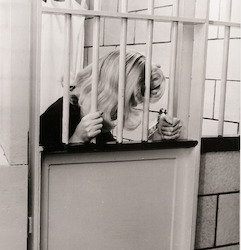
As one of his final acts in office, Mayor Jimmy Walker broke ground in 1932 for the New York City House of Detention for Women, built on the site of the old Jefferson Market jail in Greenwich Village and colloquially known as the House of D. According to sociologist Sara Harris’ Hellhole (on John Waters’ list of recommended reading), It was intended as a model of prison reform. Opened in 1934, the twelve-story monolith of brownish brick with art deco flourishes loomed behind the old Jefferson Market courthouse on Sixth Avenue, looking more like a stylish if somewhat cheerless apartment building than a prison. Windows were meshed instead of barred, and the one sign on its exterior merely gave the address, “Number Ten Greenwich Avenue.” There were toilets and hot and cold running water in all four hundred cells, and it was going to focus on rehabilitating its inmates – prostitutes, vagrants, alcoholics and/or drug addicts – rather than merely punishing them. From the start the reality was at variance with the intentions, and the facility quickly became infamous as a combination of Bedlam and Bastille. Within a decade it was chronically overcrowded with a volatile mix of inmates: women who couldn’t make bail awaiting trials that were sometimes months off, women already convicted and serving time, alcoholics and addicts, the mentally ill, violent lesbian tops, street gang girls, hookers and other lifelong multiple offenders, and teenagers spending their first nights behind bars. Tougher, more experienced prisoners brutalized and sexually assaulted the weak and inexperienced. So, of course, did the staff. The halls rang with the howls of inmates suffering the agonies of drug or alcohol withdrawal. There were cockroaches and mice in the cells and worms in the food. Village lesbians called it the Country Club and the Snake Pit. The IWW organizer Elizabeth Gurley Flynn did time in the House of D, as did accused spy Ethel Rosenberg and Warhol shooter Valerie Solanas. In 1957, Dorothy Day, founder of the Catholic Worker movement, spent thirty days there for staying on the street during a civil defense air raid drill. Her ban-the-bomb supporters picketed outside every day from noon to two; the Times called them “possibly the most peaceful pickets in the city.”
Despite its bland exterior, the House of D made its presence very known in the neighborhood through the daily ritual of inmates yelling out the windows or down from the exercise area on the roof to the boyfriends, girlfriends, dealers and pimps perpetually loitering on the Greenwich Avenue sidewalk – a carnivalesque Village tradition for almost forty years. Waters first caught the spectacle in the early 1960s. “It was amazing. No one can ever imagine what that was like. All the hookers would be screaming out the windows, ‘Hey Jimbo!’ And all the pimps would be down on the sidewalk yelling stuff.” Writer and film producer Jeremiah Newton initially encountered it at around the same time. “It was this huge, monolithic building, looking like the building the Morlocks dragged the Time Machine into, and the girls were always yelling down, screaming obscenities and throwing things out the window. It was the biggest building there. I sat on a stoop watching the people walk by. I’d never seen anything quite like it before.” The Village writer Grace Paley lived near the facility in the 1950s and 1960s, and walked her kids past it regularly. She wrote that “we would often have to thread our way through whole families calling up – bellowing, screaming up to the third, seventh, tenth floor, to figures, shadows behind bars and screened windows, How you feeling? Here’s Glena. She got big. Mami mami, you like my dress? We gettin you out baby. New lawyer come by.”
Women arrested at antiwar rallies during the Vietnam era found themselves locked up in the House of D with the hookers, junkies, crazies and butch lesbians. On Saturday, February 20 1965, two eighteen-year-old college students, Lisa Goldrosen of Bard and Andrea Dworkin of Bennington, were arrested during an antiwar protest at the UN and sent to the House of D. There, they later testified, they were brutally mistreated and humiliated by male doctors “examining” them for venereal diseases, and forced constantly to fend off the rough advances of other inmates. They were not allowed to use a telephone until Monday. That March, the New York Post ran an exposé based on their testimony. They didn’t experience anything other women hadn’t for thirty years by then, but in the 1960s those other inmates were overwhelmingly poor black and Hispanic women. Dworkin and Goldrosen were white, middle-class college coeds. As so often happens, that’s what it took to generate public outrage.
When Grace Paley herself was arrested at another war protest some months later, she was detained in the facility. Conditions had slightly improved in light of the outcry the Post had stirred up. Paley had been arrested before at antiwar protests, but it had always resulted in at worst overnight stays. This time a judge threw the book at her and gave her six days. “He thought I was old enough to know better,” she later wrote, “a forty-five year old woman, a mother and teacher. I ought to be too busy to waste time on causes I couldn’t possibly understand.” At least she could look out her cell window and watch her kids walking to school.
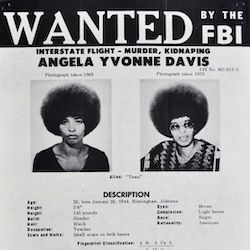
In October 1970, Angela Davis was arrested in the Howard Johnson Motor Lodge at Eighth Avenue and Fifty-First Street and taken to the House of D. It was not her first time in Greenwich Village. She was born in 1944 in Birmingham, Alabama, where her father was a car mechanic and her mother was a teacher and a civil rights activist. They lived in a black neighborhood called Dynamite Hill because the Klan had firebombed so many homes there. With help from the American Friends, she and her mother moved to New York, where her mother studied for her Masters at NYU while Angela attended Elisabeth Irwin High School in the Village. She went on to study philosophy at Brandeis, the Sorbonne, and at the University of California, earning her Ph.D. One of her teachers was Herbert Marcuse. By the late 1960s she was an avowed Communist, a member of the Student Nonviolent Coordinating Committee and affiliated with the Black Panthers. She lectured in philosophy at UCLA until 1969, when her Communist and radical affiliations got her fired.
In August of 1970 a black teen named Jonathan Jackson took over a Marin County courtroom and demanded the release of his older brother, Panther member George Jackson, from nearby Soledad prison. He took the judge, the district attorney and three jurors hostage. In the attempted getaway, Jackson, the judge and one other person were shot and killed. When police discovered that Davis, who knew George Jackson, was the registered owner of Jonathan’s weapon, she was charged as an accomplice to murder, a capital crime in California. She fled the state, which put her on the FBI’s most wanted list. A beautiful twenty-six-year-old with a huge and magnificent Afro, she became a global pop star of the revolution a la Che Guevara. When the FBI arrested her she’d spent a few days walking openly in Times Square, unrecognized because she’d slicked down the Afro and dressed like an office worker.
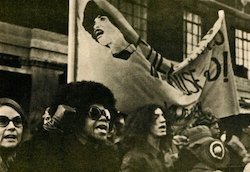
Within thirty minutes of her being locked up in the House of D a crowd of protesters began to gather outside the monolith, chanting; prisoners stood in their windows and chanted along, their fists raised. The NYPD sent a Tactical Defense Force unit – riot police – and House of D officials turned off all the lights inside, hoping to quiet things down. Instead, women set small fires in their cells, and demonstrators cheered the flickerings in the windows. They dispersed without major incident. Placed in isolation, Davis went on a ten-day hunger strike. She spent nine weeks in the facility while fighting extradition to California, where, she was quite convinced, she’d be convicted and put to death. In fact she would be acquitted of all charges in a San Francisco courtroom in 1972, after spending eighteen months behind bars.
Davis was the facility’s last celebrity tenant. Through the 1950s and 1960s, Greenwich Village civic and neighborhood groups had constantly called for the facility to be removed to some location more appropriate, which is to say far away from where they lived and walked their children to school. More liberal souls in the neighborhood thought it should stay, fearing that if the women were shifted to some more isolated location they might be all the more easily mistreated. Before he wrote the hit Broadway musicals Hello, Dolly! and La Cage aux Folles, Villager Jerry Herman wrote a satirical revue called Parade, which included a song about the House of D controversy:
Don’t tear down the House of Detention
Keep her and shield her from all who wish her harm
Don’t tear down the House of Detention
Cornerstone of Greenwich Village charm…
So I say fie, fie to the cynic
Know that there’s love in these hallowed walls of brown
There’s love in the laundry, there’s love in the showers,
There’s love in the clinic
'Twas built with love, my lovely house in town
Save the tramp, the pusher and the souse
Would you trade love for an apartment house?
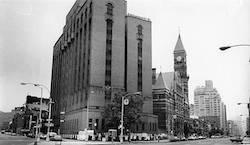
Dworkin and Goldrosen’s testimony before a commission studying conditions at the House of D helped lead to its being shut down in 1971. Inmates were moved to a new facility on Rikers Island. After some debate about possible new uses for the Village monolith, it was simply torn down in 1973. The site is now a small, fenced-in garden. In 1974 Tom Eyen’s spoofy play Women Behind Bars, set in the House of D in the 1950s, premiered. John Waters’ star Divine performed in a later production.
by John Strausbaugh
11 notes
·
View notes
Text
MEET THE PRESS
August 3, 1969
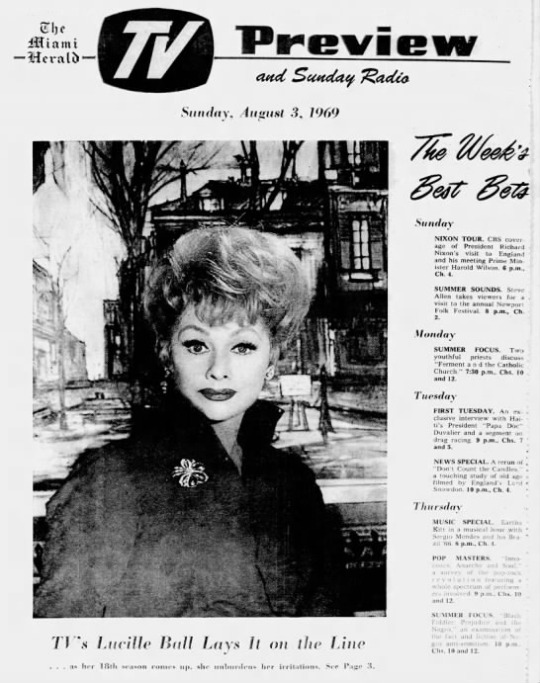
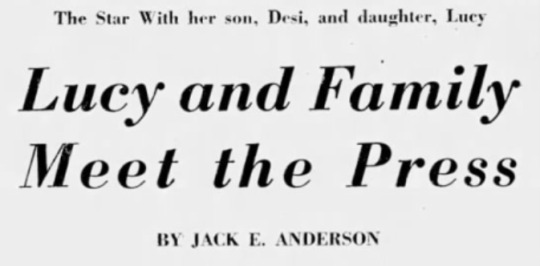
You are clued into the frank and tough talk to come by the way Lucille Ball swipes away with her handkerchief at the flies threatening the hors d’oeuvres The kerchief almost snaps like a wet towel.
The scene is the pool patio of her home on Beverly Hills’ Roxbury Drive and a cocktail party is in progress for visiting television editors.
Lucy has just emerged from the main house. She wears a powder blue double-breasted slack suit and saucer-sized sun glasses. In the blazing sun her orange hair has the color intensity of hot coals.
She has counted heads. Husband-producer Gary Morton is there. So are Desi Arnaz IV her son, and Lucy her daughter. And her TV side-kick Gale Gordon with his wife. Plus a half-dozen of her staff and CBS emissaries. There have been introductions all round to the newspaper types. It is time, she announces, to talk and she waves everybody into the big and comfortable pool house. A table has been positioned so that she can sit there presiding as she used to do at the stockholders’ meetings of the old Desilu Studios.
Almost immediately some wag fields her the question: “Lucy do you run the show?” She flashes him that big innocent TV look of hers. A staff member jumps up “Let’s all answer that one for her” There is a resounding “YES” from family-and-cast. Everybody laughs uproariously.
Very few questions are required to prime the pump. Lucy, it seems, has some matters of personal irritation on her mind and as far as she is concerned they come tumbling out without any prodding from her would-be interrogators.
First of all, she asks rhetorically, what’s all this business about whether she would retire? “I never said I wanted to quit or retire. There was a time when I was willing to quit but nobody asked me. Now I’ve set a date when I’ll retire”
A lot of ears perk up Somebody asks slyly — when? She’s waiting for that. Her answer is smilingly emphatic: “When I drop dead in my tracks.”
She turns then without anybody’s questioning to the matter of her longevity in television. This is her 18th year on the tube and it used to be talked about that she traded her popularity to CBS in return for its buying other shows produced by her company. This evokes an almost visible jet of steam out of the top of her carrot locks. “I never at any time sold any of the 20 shows our company produced on the basis of my returning each season. I’ve said that literally hundreds of times and nobody believed it.”
She went on to make it clear that she also dislikes the “big business” image which has adhered to her over the years. “I never like to talk about big money. I make my deal and that’s all. It’s been mostly a matter of legal procedures.”

As the star wades into these fiscal subjects your eye roams over the assemblage. Young Desi in tennis togs impassively studies the smoke curling up from a cigarette. Young Lucy clutches her hands around her knees and stares intently at her mother. Husband Gary sitting on a ledge at the back of the room swings his legs and smiles.
There has been no mention of Desi the elder the former husband Lucy’s co-performer and co-founder of Desilu Studios (now sold). Earlier this writer had chatted briefly with young Desi. He said he saw his father off and on and spends his summers as a rule at the father’s beach home at Delmar, south of Los Angeles.
The youngster asked if I knew his grandfather Dr. Desiderio Arnaz who lives in Coral Gables. (1)
But back to Lucy She’s telling us how many years it took to realize that as Lucille Ball she had attained V.I.P. status.
She reviews the years she spent trying to make it in show business, first on the stage, then as a model, and finally in the movies. Much of the time she says she stagnated. Until television came along.
“I never had any sense of importance. I was very pliable always willing to do what I was told It wasn’t until one day I saw in print somewhere some actress described as a ‘Lucille Ball type’ that I knew suddenly I was somebody and a part of the business.”
From there on the interview jumps from subject to subject.
I ask her whatever happened to the project Dean Martin’s producer Greg Garrison had for starring Martin, her, and Jackie Gleason in a revival of the musical “Guys and Dolls.” (2)
“I never said I would do it. Garrison kept publicizing it, but he never cleared it with me. I do still want to do ‘Diamond Jim’ with Jackie It’s just a matter of finding the time.” (3)
A lady editor wants to know how Lucy keeps her sinuous figure.
“I don’t particularly like food. I’m not very fond of meat, for example, except in the morning.”
Which brings a snort of disgust from her husband. “Can you imagine what it’s like to have to watch her eating corned beef or hamburger at 6 o’clock in the morning?”
The questions now go to the children. What are Desi’s plans? Does he want to make acting his future? “I want to be an actor for awhile but I don’t think I ever want to be one certain thing.”
Young Lucy, who, at 18, is two years older than her brother, is more sure of her future “I’ll go to college for awhile but I like acting. I’ll stay at it if I can.”
Would she somebody asks join the campus protest and carry a sign? Only if it says ‘wet paint’ quips she.
Lucy now introduces her cast veteran, Gale Gordon. He pays her extravagant compliments and talks a bit about his radio and early television days.
The interview’s late arrival is venerable George Marshall, who is now the show’s director. Lucy introduces him as “our sexy senior citizen.” Marshall goes back to the dawn of movies and is filled with fascinating anecdotes about his years in the business. (4)
The conversation turns to TV’s talk shows. Somebody suggests to Lucy that she would be a highly likely guest for Merv Griffin’s new show starting on CBS Aug 18. (5)
Lucy's answer comes lancing back “That’s what you think. I don’t like him.” Which rocks everybody back. Why not? “Because he doesn’t know how to interview. He’s rude to his guests and he monopolizes the conversation.”
She doesn’t wait for the next question. “I’m wild about Dick Cavett (on ABC) I think he’s great And I told Bill Paley (board chairman of CBS) he should have him on our network. But Bill said ABC got him first and we’re out of luck.” (6)
Everybody is suddenly distracted by three teen-age girl fans leaning over a fence way up front. They’re begging to be allowed on the grounds. Morton jogs forward to shoo them away.
“This happens all the time,” says Lucy. “My God they used to picnic right in front of the house until our police department stopped them. Jimmy Stewart, who lives up the street, finally told me how to keep them away. Turn on the lawn sprinklers.”
Morton returns and takes everybody for a tour of their luxurious but very lived-in home. Lucy tells us a funny story about how Jack and Mary Benny had once been their next door neighbors sold their home then asked her to try to mediate a re-sale of the place back to them. Then we take our leave.
# # # FOOTNOTES FROM THE FUTURE

(1) Dr. Desiderio Alberto Arnaz y Alberni II (1894-1973) was a Cuban politician and the father of Desi Arnaz. He graduated from the Southern College of Pharmacy in 1913 in Atlanta, Georgia. Desiderio Arnaz II was the youngest mayor of Santiago de Cuba (1923–32). When president Machado was overthrown in August 1933, Arnaz was arrested and jailed. Six months later, he was allowed to go into exile. He married Dolores "Lolita" de Acha y de Socias in 1916 and had one son, Desiderio "Desi" Arnaz III. He later had a daughter, Connie Arnaz (1932), with Anne M. Wilson, whom he married in 1941.

(2) Guys & Dolls was a 1950 stage musical by Frank Loesser, based on the stories by Damon Runyon starring Robert Alda, who appeared on several episodes of “The Lucy Show” and “Here’s Lucy”. It was filmed by MGM in 1955. During that time, Lucy and Desi were also under contract to MGM, so they prevailed upon “I Love Lucy” to insert a clip from the film into “Lucy and the Dummy” (ILL S5;E3). After its initial airing on October 17, 1955, the clip was removed from the film print, and for legal reasons, has never been restored. It is unclear whether Garrison’s project with Martin, Ball, and Gleason would have been a film revival, or a stage production. Whatever it was to be, Lucy wanted to have no part of it, perhaps remembering the rigors of performing on stage in Wildcat (1960). During her film career, Ball was in two films based on Damon Runyon material, The Big Street (1942), a film she claimed as her favorite, and Sorrowful Jones (1949). She also did a radio version of Runyon’s “Tight Shoes” in 1942. Ball and Gleason would have been cast as Miss Adelaide and Nathan Detroit, while Dean Martin would have played Sky Masterson, the romantic lead. Those roles were played by Vivian Blaine, Frank Sinatra, and Marlon Brando in the film. Obviously, the project never came to be.
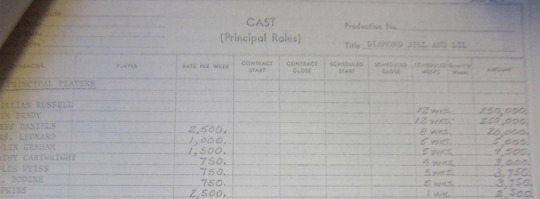
(3) “Diamond Jim” was a project that Lucy dearly wanted to make with Gleason. He would play Diamond Jim Brady (1856-1917) to her Lillian Russell. Ball even went so far as to have a script written to further grab Gleason’s attention. Despite their best intentions, Gleason and Ball’s schedules never allowed for enough time to make the film.
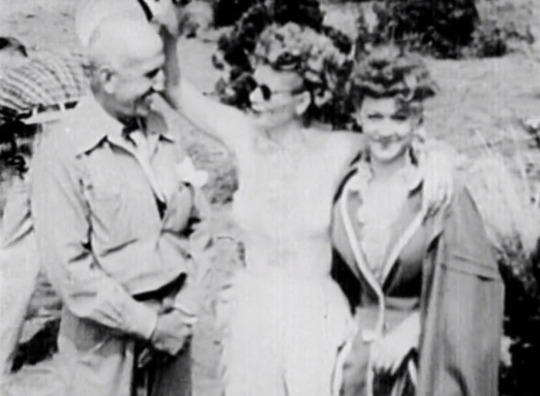
(4) George Marshall (1891-1975) had directed Lucille Ball in Valley of the Sun (1942) and Fancy Pants (1950). He was considered an expert at location shooting, so when “Here’s Lucy” wanted to spend the first four episodes of Season 2 on location, Marshall was hired as director. He stayed on for seven more episodes of the sitcom before bowing out.
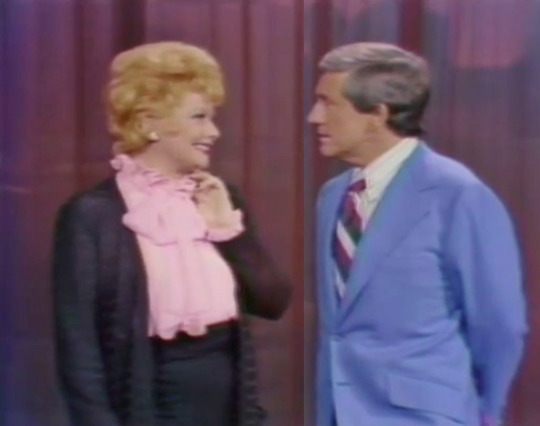
(5) Despite Lucille Ball’s rather harsh public assessment of Merv Griffin (1925-2007) at this August 1969 press party, Ball appeared on “The Merv Griffin Show” four times between 1971 and 1980! During her first appearance, the aforementioned George Marshall was also a guest!

(6) Lucille did seem to enjoy doing the talking to Dick Cavett, although she only got to do his chat show once, on March 7, 1974, in conjunction with her press tour for Mame.
#Lucille Ball#1969#Press Party#Dick Cavett#Merv Griffin#TV#Here's Lucy#Gary Morton#Lucie Arnaz#Desi Arnaz Jr.#Guys and Dolls#George Marshall#Jack E. Anderson
4 notes
·
View notes